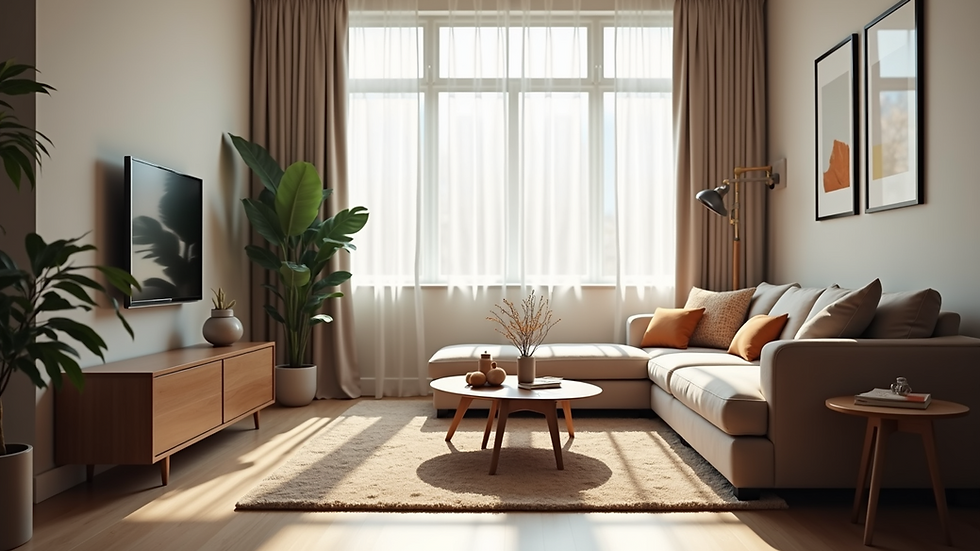THE ART OF BALLANCE: The Key to Harmony in Interior Design
- NOLEN CARTER

- Aug 6
- 4 min read
Updated: Aug 24
Achieving balance in interior design is a journey that many aspire to but few master. Whether you’re revamping a single room or designing your entire home, understanding the importance of balance can create a sense of peace and bring your vision to life. In this blog post, we’ll explore what balanced interior design means, delve into various principles that contribute to achieving balance, and highlight practical tips to create an inviting and harmonious living space.
Balanced Interior Design
Balanced interior design is about creating a perfect equilibrium among various elements in a space. This equilibrium can be achieved through symmetry, color matching, and spatial arrangement. When these elements work in harmony, they contribute to the overall aesthetic appeal and functionality of the environment.
Importance of Balance
Balance plays a crucial role in making a space feel comfortable and visually appealing. A well-balanced room can induce relaxation and tranquility, while a poorly balanced room can feel chaotic and stressful. The perfect balance can lead to effective space utilization, allowing both beauty and function to shine.
For instance, when all furnishings in a living room are heavy and dark, it might feel oppressive. Introducing lighter colors or textures can drastically alter the perception of that space. According to a study published by the Journal of Environmental Psychology, spaces with balanced interior design can significantly enhance mood and cognitive function.

What Does Harmonious Mean in Design?
Harmonious design refers to creating a cohesive atmosphere by ensuring that all elements within the space complement each other. This involves working with colors, patterns, textures, and forms that play together without conflict. For example, if you choose a modern sofa with clean lines, pairing it with drapery that has a similar geometric pattern will create a sense of unity in the design.
Understanding the psychological effects of color can also be instrumental. Colors can evoke different emotions. A palette of soft blues and whites can provide a calm environment, while vibrant colors can energize a space. Blending contrasting colors might create dynamism, but it is important to do so in moderation to avoid overwhelming the senses.
Achieving Balance Through Color
Color selection is one of the most effective ways to achieve balance in interior design. Colors can be divided into warm and cool tones, each offering a unique vibe.
Warm Colors: Reds, oranges, and yellows can create a cozy, inviting atmosphere. However, too many warm tones can evoke feelings of stress or discomfort.
Cool Colors: Blues, greens, and purples are calming and can promote serenity. Employing these colors in moderation will help keep a room feeling fresh without falling into monotony.
To achieve a balanced look, consider utilizing the 60-30-10 rule. This rule suggests that 60% of the room should consist of a dominant color, 30% as a secondary color, and 10% as an accent color. Doing this not only streamlines your choices but also ensures that no single color overpowers the rest.

Spatial Arrangement for Balance
How you arrange the furniture can significantly impact the balance of a room. Here are a few tips to remember:
Symmetry: Placing two similar items across from each other can create a sense of order. For example, two armchairs flanking a coffee table in a living room can establish visual stability.
Asymmetry: Achieving balance doesn’t always mean symmetry. An asymmetrical arrangement, where different yet complementary pieces are used, can also create balance. For instance, a large sectional sofa paired with a slim console table on one side can provide visual interest without feeling cluttered.
Negative Space: Don't hesitate to include negative space, which is the empty space around your furnishings. This gives the eye a place to rest and can help emphasize balanced elements in the room.
Scale and Proportion
Understanding scale and proportion plays a key role in achieving balance in design. Scale refers to the size of an object in relation to its surroundings. Proportion is the ratio between different elements within the space.
For instance, a large, oversized sofa in a small room can feel out of place. On the other hand, a tiny piece of furniture in a large, open space might get lost.
To maintain balance, it is vital to choose furniture that complements the proportions of your space. In a room with high ceilings, vertical elements such as tall bookshelves or floor-to-ceiling curtains can draw the eye upward and create a feeling of grandeur.
Using Texture for Depth and Interest
Texture adds depth to a design and can significantly contribute to balance. A room might feel flat or one-dimensional without texture. Combining various materials, such as wood, metal, textiles, and glass, can evoke layered complexity, making the design more dynamic.
You can incorporate texture in the following ways:
Fabrics: Utilize different fabrics such as velvet cushions, linen throws, and shaggy rugs to add warmth and comfort.
Natural Elements: Incorporate elements like wooden furniture, stone accents, or plants to connect your interior design to nature.
Lighting: Varying the types of lighting can also introduce texture. Consider soft, diffused lights alongside brighter, task-oriented lights to create a layered effect.

Final Thoughts on Creating Balance
Ultimately, achieving a balanced interior design is about understanding how the elements of a room work together. By focusing on color, arrangement, scale, texture, and other design principles, you can cultivate an environment that invites relaxation and joy.
Incorporating balance into your design can enhance functionality while providing a visually appealing atmosphere. With a few thoughtful adjustments, your home can evolve into a harmonious haven that reflects your personal style and fosters a sense of peace. Remember, achieving balance is not just about the aesthetics; it’s about creating a space where you can thrive. Explore more about the elements of harmony in design and let your creativity flow!



Comments